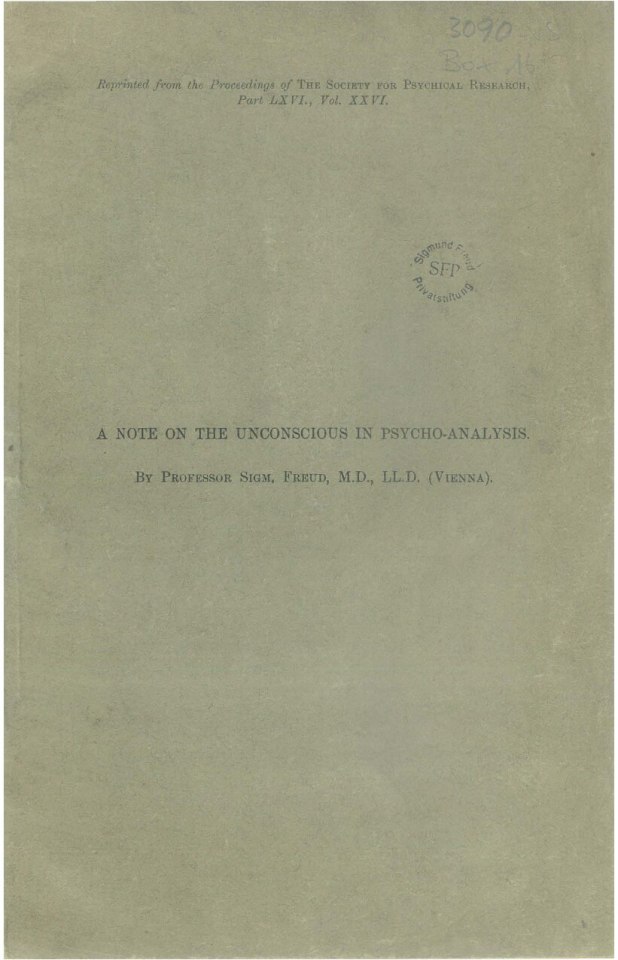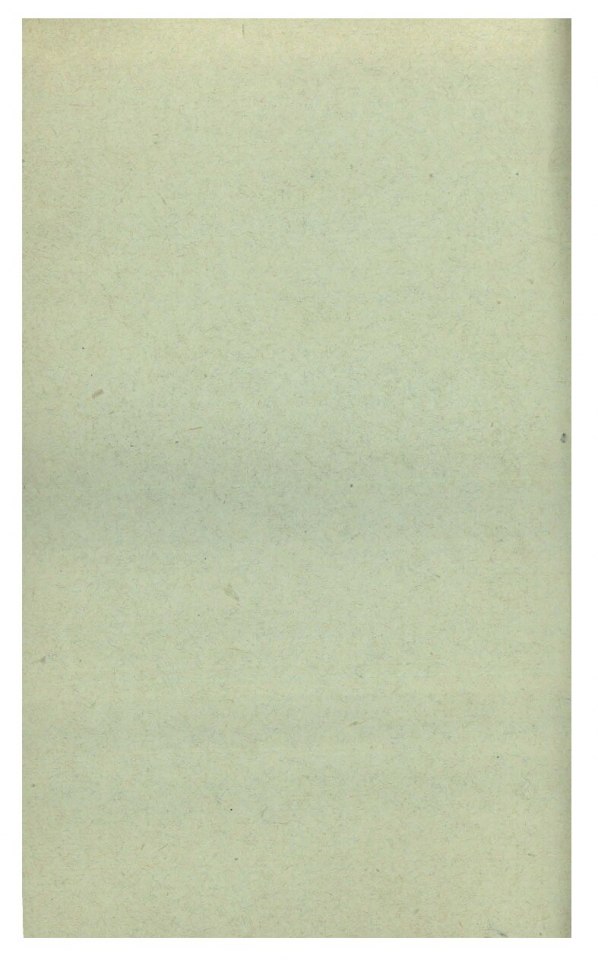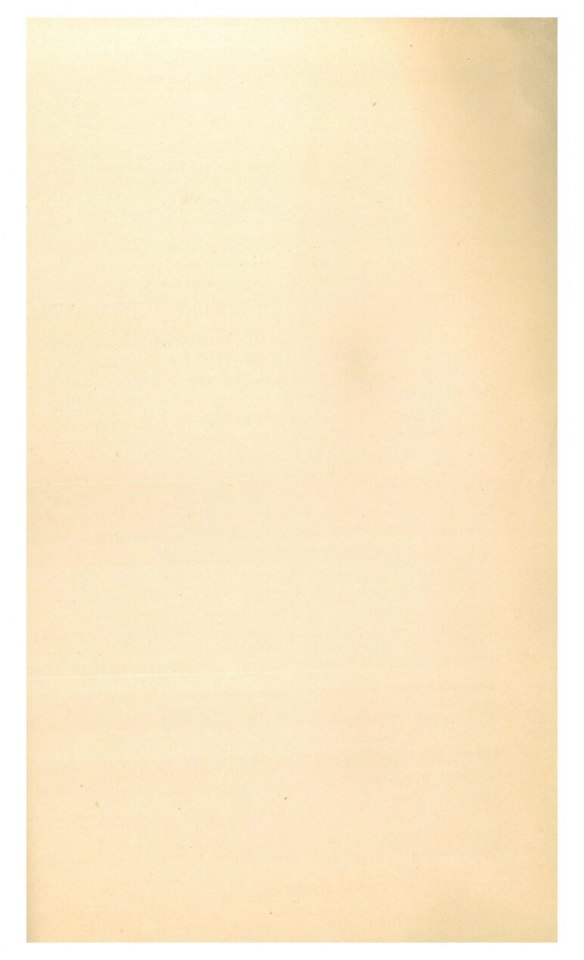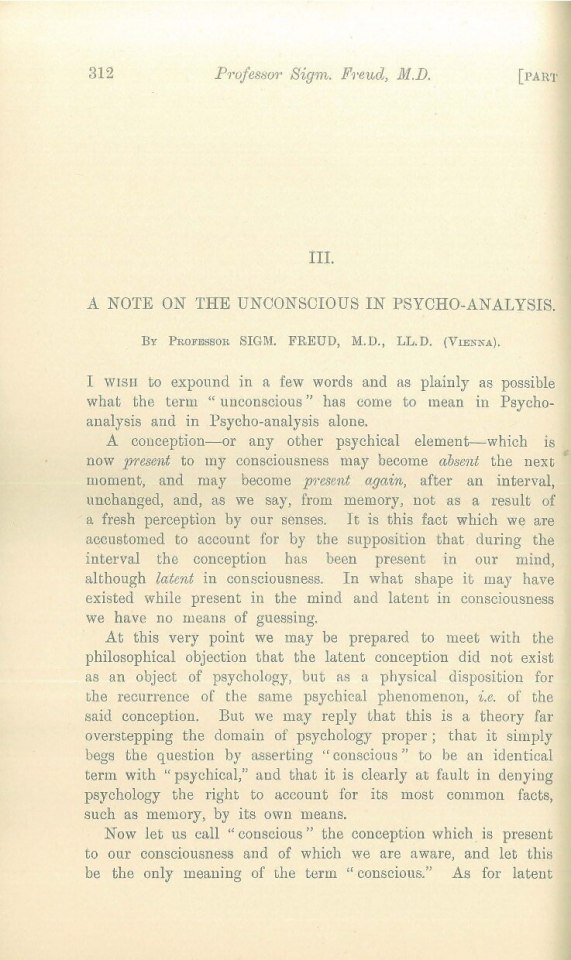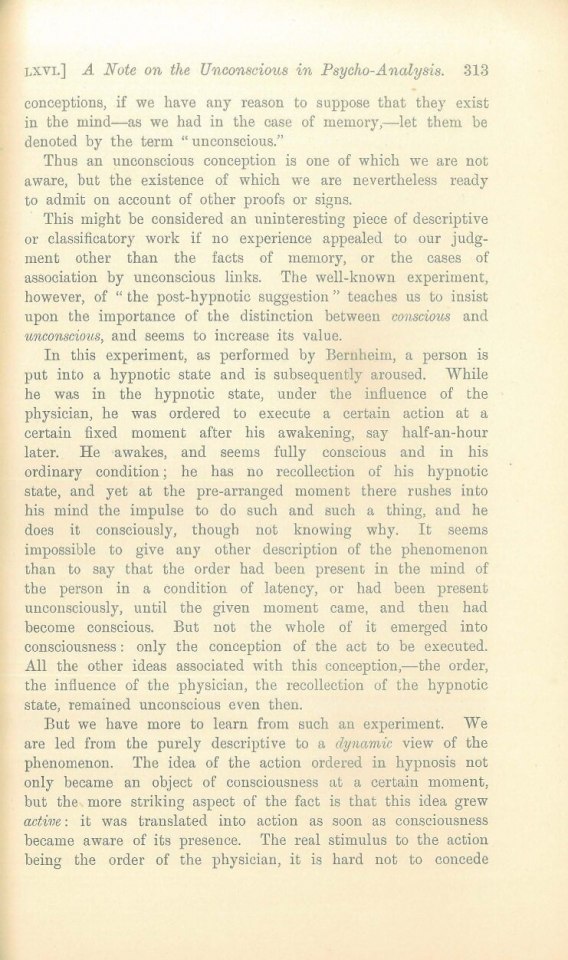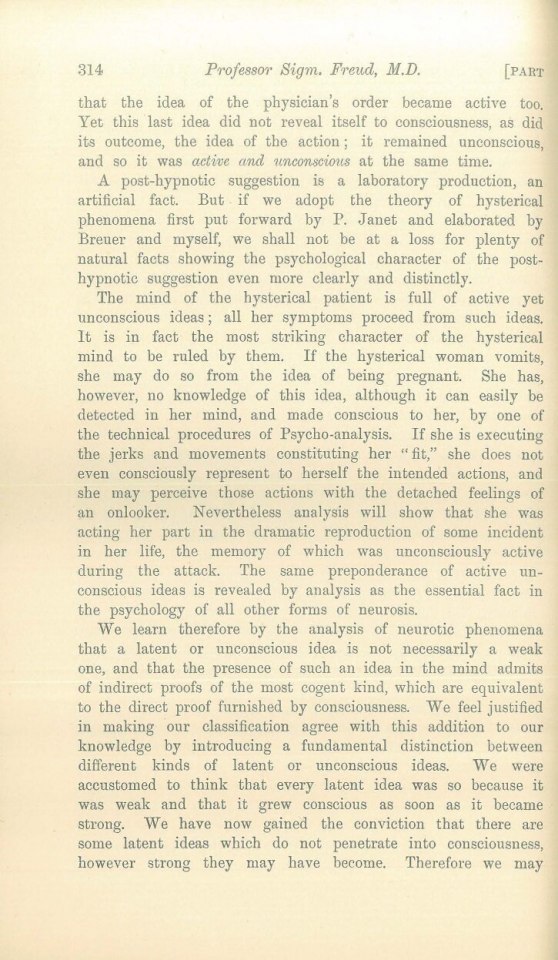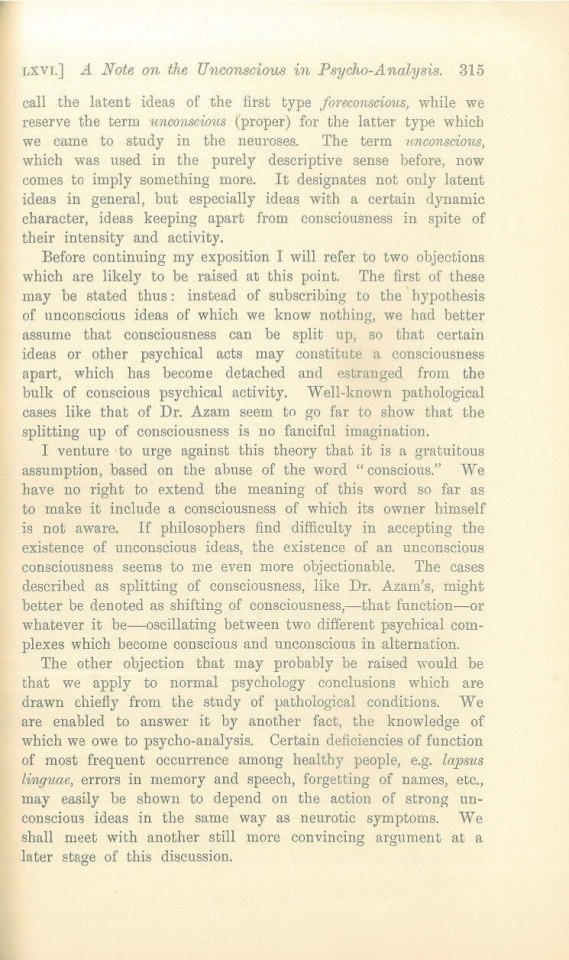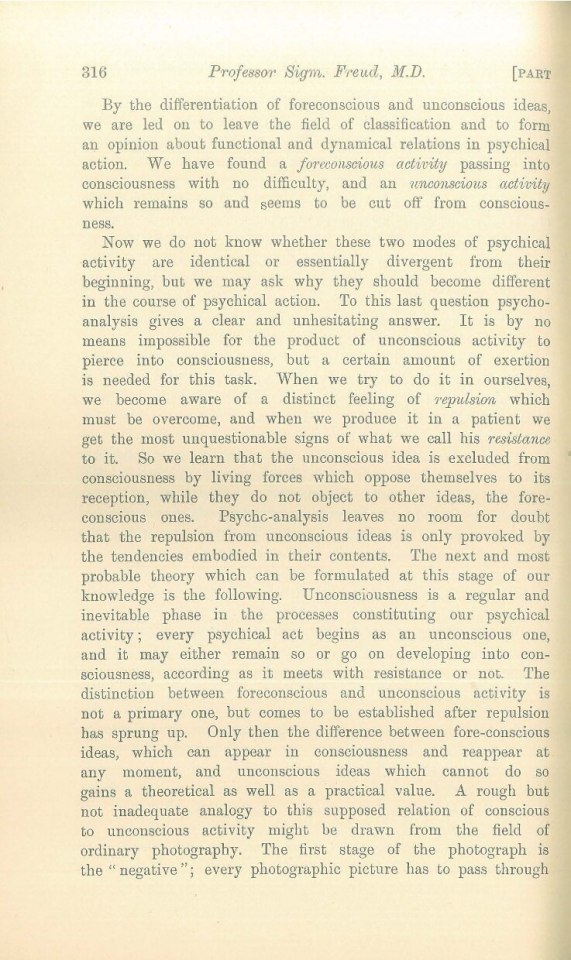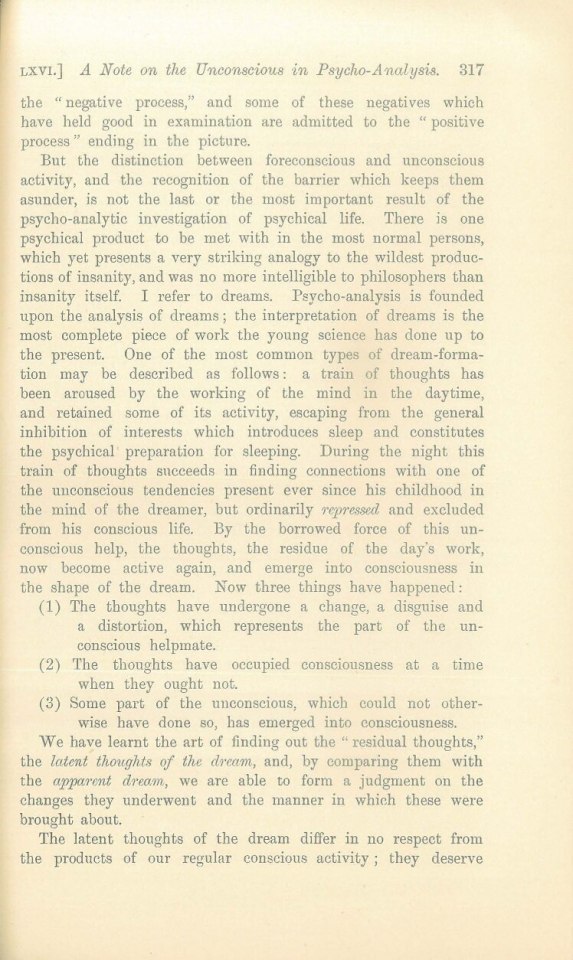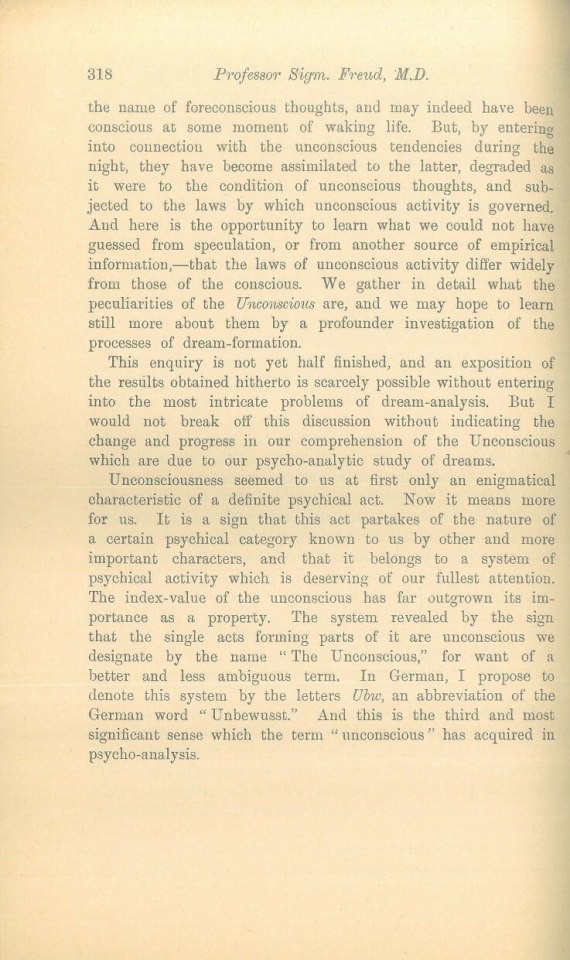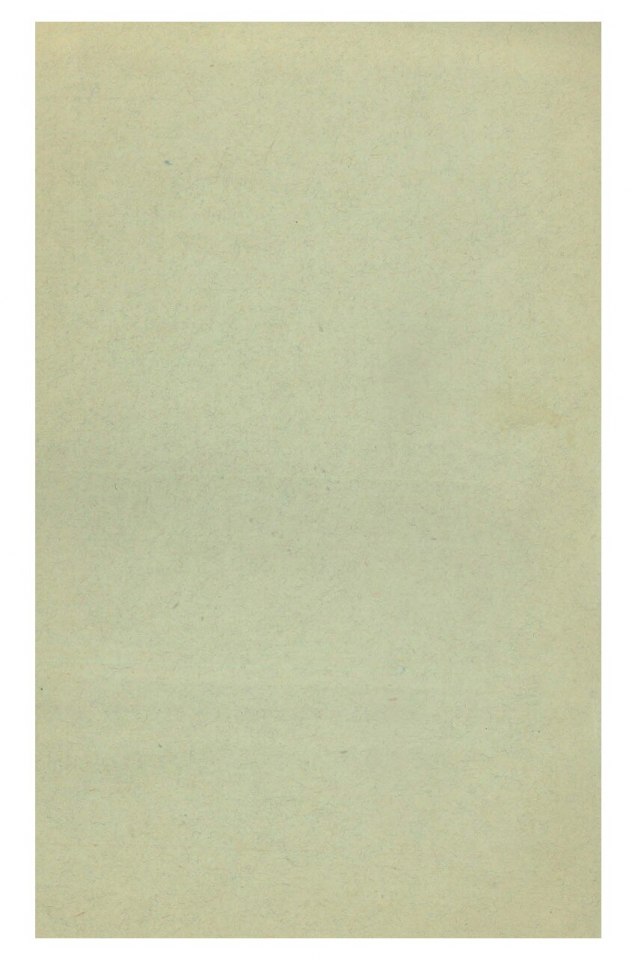S.
S.
S.
S.
312 _/l'sso7‘ Siym. Freud, MI). [mm-
III.
A NOTE ON THE UNCONSCIOUS IN PSYCHO-ANALYSIS.
BY Pnumssun SIGM. FREUD, M.U.‚ LL.D‚ (V1ESXA).
I WISH to expound in a few words and as plainly as possible
What the term “uucuusoious" has come to mean in Psycho-
analysis and in Psycho-analysis aloneA eouception—or any other psychical element—which is
now present to my consciousness muy became absmt the next ‘
moment, and may become present again, after an interval,
unehanged, and, as we say, from memory, not es a result of
a fresh pereeption by our senses, It is this fact which we are
accustoined to account for by the supposition that during the
interva_l the conceptlun has been present in our mind,
elthough latmt in cnnsciuusness, In what Shape it may have
existed While present in the mind and latent in conscimisness
we have no means of guessing.At this very point we may be prepared to meet with the
philosophicnl objection that the latent conception did not exist
as an object of psyohnlngy, but as :: physical dispositiou for
the reenrrence of the same psychical phenomenon, i.c. of the
seid eoneeption. But we may reply that this is a theory far
overstepping the domain of psychology proper; that it simply
begs the question hy asserting “eonscious” to be an identical
term with “psycliieal,” and that it is clearly at fault in denying
psychology the right to account for its most common facts,
such as memory, by its own means.Now let us call “consciuus” the conception which is present
to our consciousness and. of Which we are aware, and let this
he the only rneening of the term “conscious." As for latentS.
|‚XVL] A Note on the Ufizco'mft‘ious in Psyclw—Annlys-ls. 313
„onceptions, if we have {my reason to snppose that they exist
in the mind—ns we had in the car: of nmnmi'y,—let them he
delmted by the term “uncunseiuus.”Thus an uneouscious conception is one of which we are not
aware, but the existence of Which we are nevertheless ready
to admit on account of other proofs er signs.This might be considered an nninteresting piece of descriptive
ur clr1ssiiieatory work il' no experience ;tppeatlenl to our _jurlg-
ment other than the facts of memory, or the cases of
association by unconscious links. The well—known experiment,
however, of “ the post-hypnntio suggestion” teaehes us to insist
upon the importance of the distinction between cm;,stious and
’1L7ZL‘ün—Sßiülls, and seems to increase its value.In this experiment, as performed by Bernheim, a person is
put into a hypnotic state and is subsequently aroused. \\’hile
he was in the hypnotie state, under the influence of the
physiciem, he was ortlei'ed to exeuute EL certain action at zt
certain fixed moment after his awakening, say halfen-hour
later. He awakes, and seems fully conscions and in his
ordinary condition; he has no reuolleetion of his hypnotie
state, and yet at the pie-arranged moment there rushes into
his mind the implilse to do such and such a thing, and he
does it eunscinusly, though nut l<nowing Why. It seems
impossihle to give any other description of the phenomenon
than to say that the order had been present in the inian of
the person in & condition of littency, or had been present
nneonsciously, until the given moment come. and then lied
become conscious. But not the whole of it einßrgetl into
consciousness: only the conceptinn uf the net to be executetl.
All the other ideas associated with this eenception‚«the order,
the influence of the physicinn, the 1eoollection of the. hypnotie
state, remained unconseious even then,But we have more to learn from such an experiment. We
are led from the purely descriptive to & zIy/trmttw view of the
phenomenon. The idea of the action ordered in hypnosis not
only became an object of consoiuusness ut a certain moment,
but the more striking uspeet of the fact is that this idee grow
antiw: it was trunsleted into action as soon as cnnsciousness
became aware of its preseuce The real stimnlus to the action
being the order of the physieian, it is hard not to eoneedeS.
314— Pv'ofcssüa' Sigm. Freud, M‚D‚ [ran-r
that the idea of the physician's order became active too_
Yet this last idea did not rcveal itself to consoiousness, as did
its outeonxe, the idea of the action; it i‘cmained unconscions,
and so it was active und 7mcemcions at the same time,A posthypnotic suggestion is a laboratory production, an
artificial fact. But if we adopt the theory of hysterical
phenoniena first put forward by F. Janet and elaborated by
Breuer and myself, we shall not be at a. loss for plenty of
natural facts showing the psychological character nl" the post-
hypnotie snggestion even more elearly and distinetly.The mind of the hysterical patient is full of active yet
nnconscinns ideas; all her syn\ptoins proceed from such ideas,
It is in fact the most striking character of the hysterical
mind to be ruled hy them. If the hyaterieal Woman vomits,
she may do so from the idea of being pregnant. She has,
however, no knowledge of this idea, althongh it can easily he
detected in her mind, and made conscious to her, by one of
the technical procedures of Psycho-analysis. If she is executing
the jerks and movements constituting her “fit,” she does not
even consciously represent to herself the intended actions, and
she may pereeive those actions with the detnchßd feelings of
an onleoker. Nevertheless analysis will show that she was
aeting her part in the dramatic reproduction of some incident
in her life, the memory of which was unconsoionsly active
during the attack. The same preponderance of active un-
cunscinus ideas ia revealed by analysis as the essential fact in
the psychology of all other forms of nenrosis.We learn therefore by the analysis of neurotic phenemena
that & latent or unconscions idea is not necessarily a week
one, and that the presence of such an idea in the mind admits
of indirth proofs of the most cogent kind, which are eqnivalent
to the direct proof furnished by oonseiousness. We feel justified
in making our Classification agree with this addition to our
knowledge by introdueing a fundamental distinetiun between
difi"erent kinds of latent or uneonscious ideas. Vl’e were
accustomed to think that every latent idea was so because it
was weak and. that it grew conscions as soon as it became
strong. We have now gained the eonviction that there are
some latent ideas which do not penetrate into Conseionsness,
however strong they may have become. Therefore we mayS.
i‚xw'l.] A Note an Hm Uncanaciou‚s in I’syclm-Analysts. 315
call the latent ideas ei the first type _forfconscious, while we
reser\'e the term uncnnsainus (proper) for the letter type which
We came to study in the neuroses. The term z!7zcmxsciaus‚
which was used in the purely descriptive sense \»cfore, now
comes to imply something more. Tt designates not only lntent
ideas in general, but especielly ideas with a certain dynamic
character, ideas keepiug apart from conseiousiieas in spite of
their intensity and activity.Before mntinmnfl my exposition l will refer to two olijections
which are likely to he raised at this point. The first of these
may be statecl thus: instead of subscrihing to the hypothesis
of unecnscions ideas of which we know nothing, we had better
assume that consciousness can be split up, so that certain
ideas or other psychical acta may constitute a consciousuess
spart, Which has become detached und estrangerl from the
lmlk of conscious psychieal activity. \'ell-knnwn pathological
cases like that of Dr. Azaui seem to go fiir to show that the
splitting up of consciousness is no faneilul imaginatimi.1 Venture to urge against this theory that it is & gratnitous
assumption, based on the abuse of the word “conscious." We
have no right to exten<l the ineaniug of this word so far as
to make it include a conseiousness of which its owner himselt
is not aware. li philosophers iind dilficulty in accepting the
existence of unconscious ideas, the cxistence of an uncunscions
consciousness seems to me even more nl)jectionahle. The cases
described as splitting of eonseiousness, like Dr. Azom’s, might
better he (lenoted os shifting of cousciousness‚»—thnt function—or
whatever it he—oseillating hetween two different psychical com»
plexes which become eonscions and nnconsoions in alternation.The other objection that may probably be mise<l would be
that We apply to normal psycholcgy conclusions which are
drawn chielly from the study of pathologieal conditions. We
are enabled to answer it by another fact, the knowledge ot
Which We owe to psycho-analysis. Ccrtain üeficiencies of function
of most frequent occurrence among healthy people, e.g. lnpsua‘
linguaa, errors in memory anti speech, forgetting of names, etc.,
may easily be shown to depend on the action of strong nn—
conscious ideas in the same way as neurotic symptoms. We
shall meet with another still more eonvincing argument at a
later stage of this discussion.S.
316 Pro essor Sigm. Freud, M.D, [PART
By the (liffercntintion of forecouscious and unconscious ideas,
we are led on to leave the field of classificzxtion and to form
an opinion about functional and dynamical relations in psychical
action. We have found a fu1wwiscious activity pnssiug into
consciousncss with nn diihculty, und nu IIIZL‘07LSCiUILS actim'tgy
which remains so and seems to be cut off from conscious»
ness.Now we do not know whether these two modus of psychical
activity are identical or essentially divergent from their
beginning, but we may ask why they should become different
in the course of psychical action. To this last question psycho-
analysis gives a clear and unhesiteting answer, It is by no
means impossible for the product of unconscious activity to
pierco into consoiousness, but it certain amount of exertion
is needed for this task. When we try to do it in ourselves,
we become aware of & distinct feeling of 7‘qmlsilm which
must be overcome, iind When we produce it in a patient we
get the most unquestionable signs of what we call his resistance
to it. So we learn that the unconscious idea is excluded from
conscionsness by living forcee which oppose themselves to its
reception, while they do not object to other ideas, the fore-
conscious ones. Psycho-analysis leaves no wenn for doubt
that the repulsion from unconscious ideas is only pruvnked hy
the tendencies embodied in their contents, The next and most
prchahle theory which can be i'ormulated at this stage of our
knowledge is the following. Unconsciousness is a regular and
inevitahle phase in the processes constitnrjng am: psychical
activity; every psychieal act hegins es an unconscious one
and it may either remain so er go on developing into con—
sciousness, according as it meets with resistance or not. The
distinctiou between forec0nscious and unconscious Activity is
not a primary one, but comes to be established after repulsion
has sprung up. Only then the difference between forc-cnnscious
ideas, which can appear in consciousness and reappear at
any moment, and unconscinus ideas which cannot do so
gains & theoretical es well as a practicel value. A rough laut
not inudequttte analogy to this supposed relation of conscious
to unconscious activity might be drawn from the field of
ordinary photography, The first stage of the photograph is
the ”negative“; every photographic picture has to pass throughS.
LXVI‚] : Note un l/za Uazconscioua [n R°yc/za—zhmlysis. 317
the ”negative process," and some of these negatives Which
have held good in examumbiou um ndmitted to the “positive
process ” endl'ng in the picture.the Shape of the dream. Now three things have happenerl:
( ) The thoughts have undergone & change, & disgnise und
a distorm’on, which represenm the part of the un»
conscious helpznate.(2) 'he thoughts have nccupied cnuscinusness at a time
When they oughß mm(3 Some part of the uuconscious, which could not other—
The )atent thoughts of the dream difl‘er in no respect from
the products of our regular conscl'ous activity; they deserveS.
318 P7‘qfassm‘ Slym. Freud, ‘M.D.
the name of foreconsciom thoughts, mid may iudeetl have been
conscious at some moment of wnking life But, by enteringt
into connection with the unconscious tendencies during the
night, they have become assimilnted to the latter, degmded its
it were to the condition of uncunscious thoughts, and sub.
jected to the laws hy which unconscious activity is governed.
And here is the opportunity to learn what we could not have
guessed from speculation, or from another source of empirira.l
information,—that the laws of unconscious activity diliei' widely
from those of the conscious. We gather in detail what the
pecnliarities of the anansctons are, and we may hope to learn
still more about them by a profounder investigation of the
processes of dream-formationThis enquiry is not yet hulf finished, and an expusition of
the results obtained hitherto is searcer possible without entering
into the most intricate problems of dream»analysis‚ But I
would not break ofi' this discussion without indicsting the
change and progress in our comprehension of the Unconscious
whioh are due to our psycho-anelytie studyr of dreams.Unconseiousness sesnied to us at first only an enigmatical
characteristic of a definite psychical act. Now it means more
for us. It is a sign that this act partakes of the nature of
a certain psychical category known to us by other and more
important characters, and that it helongs to a system of
psychieal activity which is deserving of our fullest attention.
The indexwalue of the unconscicus has far outgrown its im«
portance es a property. The system revealed by the sign
that the single acts forming parts of it are unconscious we
designate by the name “ The Uncanscious," for want of a
better and less amhigunus term, In German, I propose to
denote this system by the letters Ubi/:, an abbreviution of the
German word “Unhewusst." And this is the third and most
significant sense which the term “uncunscious” has acquired in
psycho-snalysis,S.
S.
3090
312
–318
